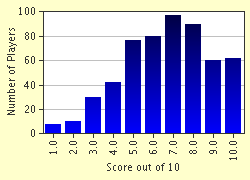Quiz Answer Key and Fun Facts
1. This great Scottish hero was portrayed by Mel Gibson in the film "Braveheart".
2. What is a "schiltron"?
3. In which battle in 1297 did William Wallace defeat an English army under the Earl of Surrey?
4. Which King of Scotland was, according to legend, inspired by a spider?
5. The traditional weapons of the Highlander included a dirk, a targe and his sword. What type of sword did he use?
6. An English army under Edward II was routed by a Scottish army under King Robert 1 at Bannockburn. In which year did this battle take place?
7. The Scottish version of the Declaration of Independence was submitted to the Pope in 1320 and stated "as long as but a hundred of us remain alive, never will we on any conditions be brought under English rule. It is in truth not for glory, nor riches, nor honours that we are fighting, but for freedom -- for that alone, which no honest man gives up but with life itself." How was this document known?
8. Following this declaration, Scotland remained free of ties with England for nearly 300 years, until the death of Queen Elizabeth I of England in 1603. Which Scottish king succeeded her to the English throne?
9. In 1707, the Scottish Parliament was effectively bribed and cajoled into voting to join with England to form one country under one King and one Parliament. Who was the monarch of England and Scotland at the time?
10. When, after 1707, did the Scottish Parliament meet again for the first time?
Source: Author
frankmcvey
This quiz was reviewed by FunTrivia editor
bloomsby before going online.
Any errors found in FunTrivia content are routinely corrected through our feedback system.

